布洛芬环境相关浓度对河流沉积物反硝化和氧化亚氮排放的差异影响
IF 11.3
1区 环境科学与生态学
Q1 ENGINEERING, ENVIRONMENTAL
引用次数: 0
摘要
布洛芬在水生生态系统中日益增加的存在对其生物地球化学功能(包括氮转化)构成了重大挑战。在这项研究中,我们采用15n标记技术研究了环境相关浓度的布洛芬(0-10,000 ng L-1)在60天内对河流沉积物中反硝化和相关氧化亚氮(N2O)排放的影响。结果显示,在硝酸盐浓度范围内(1-60 mg N - L-1),添加布洛芬对脱氮速率有驼峰状响应,在200 ng L-1布洛芬附近速率达到峰值,随后在某些较高浓度下受到抑制,与不添加布洛芬的处理相比,脱氮速率降低了25.8%。动力学分析表明,随着布洛芬浓度的增加,硝酸盐亲和力降低,但最大反硝化速率呈相同的驼峰型趋势。反硝化细菌的丰度反映了不同布洛芬浓度下反硝化率的变化规律。然而,增加布洛芬浓度持续加速N2O的生成速率。微生物分析表明,N2O产生基因的增加速度快于还原基因,而随着布洛芬浓度的增加,N2O产生基因的减少速度较慢。该研究强调了布洛芬引起的反硝化速率的驼峰响应和N2O排放的持续增加,为制定环境管理策略以减轻布洛芬和氮污染以及减少N2O排放提供了见解。本文章由计算机程序翻译,如有差异,请以英文原文为准。

Differential effects of environmentally relevant concentrations of ibuprofen on denitrification and nitrous oxide emissions in river sediments
The increasing presence of ibuprofen in aquatic ecosystems poses significant challenges to their biogeochemical functions, including nitrogen transformations. In this study, we employed 15N-labeling techniques to investigate the effects of environmentally relevant concentrations of ibuprofen (0–10,000 ng L−1) on denitrification and the associated nitrous oxide (N2O) emissions in river sediments over a 60-day period. The results revealed a hump-shaped response in denitrification rates to ibuprofen addition across a range of nitrate concentrations (1–60 mg N L−1), with rates peaking near 200 ng L−1 ibuprofen, followed by inhibition at certain higher concentrations, leading to a reduction of up to 25.8 % compared to the treatment without ibuprofen. Kinetic analysis showed that the maximum denitrification rate followed the same hump-shaped trend, despite a decrease in nitrate affinity with increasing ibuprofen concentrations. The abundance of denitrifying bacteria mirrored the pattern observed in denitrification rates across different ibuprofen concentrations. However, increasing ibuprofen concentrations consistently accelerated N2O production rates. Microbial analysis suggests that the increase in N2O production genes was faster than for reduction genes, while the decrease was slower with increasing ibuprofen concentrations. This study highlights the hump-shaped response of denitrification rates and the consistent increase in N2O emissions induced by ibuprofen, offering insights for developing environmental management strategies to mitigate ibuprofen and nitrogen pollution, as well as reducing N2O emissions.
求助全文
通过发布文献求助,成功后即可免费获取论文全文。
去求助
来源期刊

Journal of Hazardous Materials
工程技术-工程:环境
CiteScore
25.40
自引率
5.90%
发文量
3059
审稿时长
58 days
期刊介绍:
The Journal of Hazardous Materials serves as a global platform for promoting cutting-edge research in the field of Environmental Science and Engineering. Our publication features a wide range of articles, including full-length research papers, review articles, and perspectives, with the aim of enhancing our understanding of the dangers and risks associated with various materials concerning public health and the environment. It is important to note that the term "environmental contaminants" refers specifically to substances that pose hazardous effects through contamination, while excluding those that do not have such impacts on the environment or human health. Moreover, we emphasize the distinction between wastes and hazardous materials in order to provide further clarity on the scope of the journal. We have a keen interest in exploring specific compounds and microbial agents that have adverse effects on the environment.
 求助内容:
求助内容: 应助结果提醒方式:
应助结果提醒方式:


